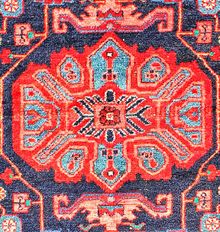Nehavand Rug
Revision as of 10:00, 29 July 2020 by Niloufar Alipour (talk | contribs)
| Nehavand Rug | |
|---|---|
 Design of Nahavand Rug (Rugman) | |
| General information | |
| Name | Nahavand Rug |
| Original name | قالی نهاوند |
| Alternative name(s) | Nahavand Carpet (Mosul Rug) |
| Origin | |
| Category | Village |
| Technical information | |
| Common designs | Medallion, Geometric, Herati |
| Common colors | Navy Blue, Red, Blue, Beige |
| Dyeing method | Natural, Synthetic |
| Pile material | Wool |
| Foundation material | Cotton |
| Knot type | Symmetrical (Turkish), Asymmetrical (Persian) |
Nahavand is a Persian tribal rug hand-woven rug, made by in the village of Nahavand, which is north of the town of Hamedan, in Northwestern Iran. Most of the Nahavands made are about 5 feet by 8 feet. They don't usually come in very large sizes because the weavers use simple horizontal looms on the ground and it is extremely difficult to construct bigger rugs. They feature floral spray designs and geometric patterns, often in a rust or reddish salmon color. The fame of the Nahavand is greatly due to the quality of the wool used to weave it. The thick soft and lustrous pile always shines under the light. Most Nahavands are soft enough for a baby to sleep on. This is a one of a kind hand made tribal rug, which has no duplicates anywhere.
History
See also
| Search for Nehavand Rug on Wikipedia. |
References
Bibliography
- Abraham Levi Moheban. 2015. The Encyclopedia of Antique Carpets: Twenty-Five Centuries of Weaving. NewYork: Princeton Architectural Press.